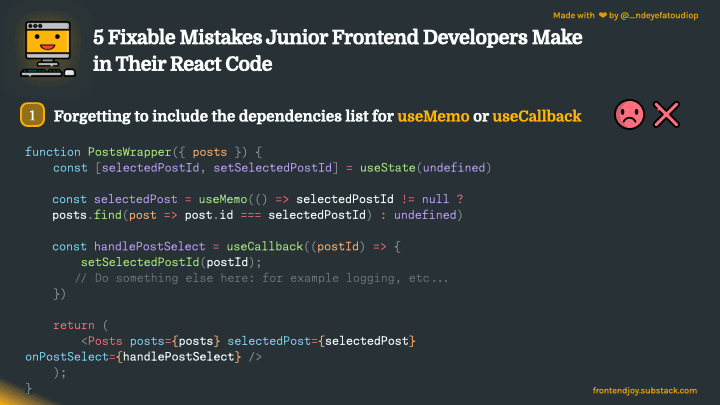- FrontendJoy
- Posts
- 5 Small (Yet Easily Fixable) Mistakes Junior Frontend Developers Make With React Memoization
5 Small (Yet Easily Fixable) Mistakes Junior Frontend Developers Make With React Memoization

I have reviewed more than 1,000 frontend pull requests.
Like many junior developers, I made some common mistakes when I started, especially regarding memoization.
If you're in the same boat, here are 5 small mistakes you can quickly fix to do memoization properly in React.
💡 Tip: You can catch a lot of these issues with eslint-plugin-react-hooks .
Mistake #1: Forgetting to include the dependencies list for useMemo or useCallback
If you're using useMemo or useCallback without depending on any component props or state, move the value returned by useMemo or the function returned by useCallback outside the component.
Otherwise, make sure to specify the dependency array as a second argument. Without it, the useMemo or useCallback function will run every time your component renders.

Mistake #2: Adding dependencies that change on every render to your useMemo or useCallback hook
When a dependency changes, the function in useMemo or useCallback reruns. So, if a dependency changes with each render, memoization becomes useless.
This issue commonly arises when:
Non-memoized arrays/objects created inside the component are used as dependencies
Non-memoized arrays/objects props are used as dependencies
So make sure you always memoize the passed dependencies, pass fewer ones, etc.

Mistake #3: Using useMemo or useCallback unnecessarily
You only need useMemo and useCallback in the following cases:
If you're computing a value that is not a symbol or an object (e.g., string, number, etc.), only use
useMemoif the computation is expensive.If you're returning a function, use
useCallbackonly when the function is a prop of a component that is wrapped inmemoor if the function will be in the dependency list of a hook (for example,useEffect)If you're returning a symbol or an object, only use
useMemowhen the value returned is a prop of a component that is wrapped inmemoor if the function will be in the dependency list of a hook (for example,useEffect)Else, you don't need them.

Mistake #4: Using memo(Component) with props that change on every render
memo helps avoid re-rendering a component when its props remain unchanged. However, if the props keep changing, memoization becomes useless.
Unfortunately, this can happen (without you realizing) when:
You pass an empty array or object to your component.
You pass callbacks that are not wrapped in
useCallbackor non-primitive values that are not wrapped inuseMemo…
So make sure the props don't change on every render. If that is not possible, drop the memo.

Mistake #5: Using memo(Component) for a component that will render anyway if its parent renders
There are situations where using memo isn't necessary because the component will automatically re-render when its parent renders:
Situation #1: If your memoized component takes children created within the parent, and these children change with every render, your component will also re-render since
childrenis just another prop.Situation #2: If your component depends on a context value that changes when its parent renders, it will also re-render, even if the specific changed part of the context isn't utilized in your component.

---
Thank you for reading this post 🙏.
Leave a comment 📩 to share a mistake you made and how you overcame it.
If you like articles like this, you’ll love the daily tips I share on X/Twitter.
Reply